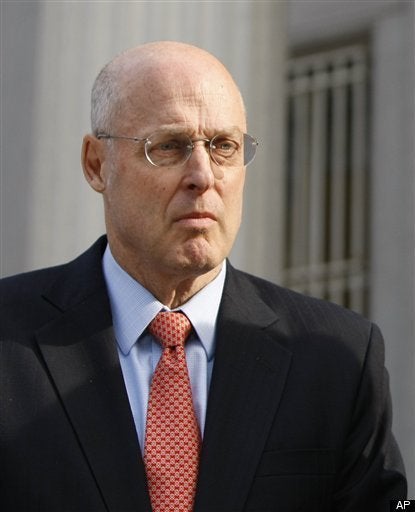
Henry M. Paulson, former CEO of Goldman Sachs and Treasury Secretary during the recent collapse of the global financial system, has written a lucid account of that crisis titled On the Brink.
Paulson gives an "I-was-there" account of how a few cracks in the financial system expanded into a global economic crackup, even as he gives an establishment view of how the global economy operates today. Few Americans are equally qualified to present such a perspective, which makes his book an interesting read.
Paulson sheds significant light on the fact that the burgeoning U.S. trade deficit actually served as the fuel for massive capital inflows from foreign central banks that encouraged Wall Street to develop highly complicated, high risk investment instruments that resulted in the most severe economic downturn since the Great Depression.
Before taking the Treasury position, Paulson was an investment banker at Goldman Sachs, one of the world's financial powerhouses. While there, he established the firm's relationship with the Chinese government and penetrated China's financial market, which has long been a dream of Western business people.
In the middle of the last decade, the Chinese, who were becoming cash-rich through their massive export surpluses with the United States, turned to skilled Wall Street investment bankers for advice. To tie those banks to China's interests, the Chinese government allowed a few to buy small equity interests in its government-owned banks.
In 2005, Paulson negotiated for Goldman Sachs a 5 percent equity interest in the Industrial and Commercial Bank of China at a price of $2.6 billion. Within six months, the value of Goldman's stock grew by almost $4 billion -- a Chinese-made demonstration to Wall Street of the money it could make by helping the Chinese government.
The Paulson view that comes through clearly is the Wall Street perspective of global trade dynamics. In this view, foreign nations, such as China, produce goods they export to America in exchange for monies that go back to China, which the Chinese government then re-sends back to the U.S., which Wall Street firms, such as Goldman, help manage.
In the past decade, "manage" in Wall Street parlance came to mean trading and speculation, something that Goldman Sachs and Paulson, when CEO of Goldman, aggressively encouraged.
Paulson's book fails to recount his role in creating the hyper-speculation of the past decade that almost wrecked the world economy. Yet, in late April 2004 senior representatives of Bear Stearns, Goldman Sachs, Morgan Stanley, Merrill Lynch, and Lehman Brothers, led by then Goldman Sachs chair Henry Paulson, met in Washington with the commissioners of the Securities and Exchange Commission (SEC). They requested the SEC to release them from its "debt-to-net-capital" rule that required the banks and their brokerage units to keep a dollar in reserve for every $12 of risk they took.
The SEC not only granted the request, it also ruled that any bank with assets of $5 billion or more could use its own model of risk to determine the debt-to-liability ratio for its own brokerage units. Paulson helped bring self-regulation to the biggest players on Wall Street.
After the SEC issued that ruling, the banks' brokerage units began wildly buying, selling, and trading hundreds of billions of dollars of two-party insurance contracts called derivatives. By December 2008, the Federal Deposit Insurance Corporation (FDIC) reported that the aggregate face value of derivatives held by U.S. commercial banks was $201 trillion, which was more than 13 times the gross domestic product of the United States in 2008.
Of this, almost 80 percent was in credit instruments, 99 percent of which were credit default swaps. Eric Dinallo, the insurance superintendent for New York, estimated that by March 2009, 80 percent of the outstanding credit default swaps were speculative.
The unnoted irony of On the Brink is that Paulson wound up in the hot seat in the U.S. Treasury when the financial speculation he fostered came crashing down. Sometimes, fate seems to have a sense of humor.
Paulson's narrative reflects a new reality in the U.S. economy -- namely its dominance by which the financial sector has led and often forced the outsourcing of so much of the American industrial base. Above all else, Wall Street pursues short-term profits, trading and speculation that it can transform into annual bonuses -- hardly a foundation for long-term national development.
A return to the older, traditional U.S. model of an economy that innovated, produced goods domestically, provided jobs, encouraged savings and then guided those savings into long-term investments, more innovation and more production is the long-term way to reignite non-inflationary, self-sustaining economic growth in America.
The resulting economic paradigm is one attributed to Abraham Lincoln and popularized by the orator Robert G. Ingersoll that says, "If we purchase a ton of steel rails from England for twenty dollars, then we have the rails and England the money. But if we buy a ton of steel rails from America for twenty-five dollars, then America has the rails and the money both."
Paulson's description of how our lopsided trade policies fed the financial crisis is an unintentional, but powerful, argument for the traditional approach to a broad-based wealth creation through innovation, production, employment, savings and reinvestment within America.